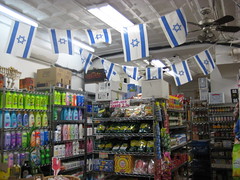 Phillip Kalantzis Cope
Phillip Kalantzis CopeGood morning, East Village.
A fire in a five-story building on First Avenue near East Third Street briefly disturbed the pre-holiday peace Wednesday night, but was quickly extinguished. EV Grieve has photos. Battalion Chief Patrick Sheridan told The Local that the fire started inside a duplex apartment on the top floor of the building and that the cause was under investigation. There were no injuries to firefighters or civilians, Chief Sheridan said, adding that all residents of the building except those living in the apartment where the fire began were permitted to return to their homes Wednesday night.
In other neighborhood news, The Times reports on a judge’s ruling against the use of “stop-and-frisk” police tactics in public housing developments; the case at issue originated a bit south of the East Village in the Baruch Houses.
And New York magazine offers a look inside the East Village apartment of the singer John Legend.
Dr. David Ores, or “Doctor Dave” as he’s more commonly known, relies on only himself to run his medical practice: He is the physician, the nurse and the receptionist. He answers all his own phone calls and e-mail messages — which are seemingly never-ending.
Dr. Ores also runs what he calls the Fresh Start program, in which he removes gang- or prison-related tattoos from the face, neck or hands of his patients free of charge. Dr. Ores — who often serves uninsured and low-income patients through a pay-what-you-can philosophy — cites the stigma attached to prison tattoos and notes that those who wear them are often unable to afford removal procedures.
“There are people out there who are willing to help them if they’re willing to help themselves,” he says.
NYU Journalism’s Rachel Wise reports.
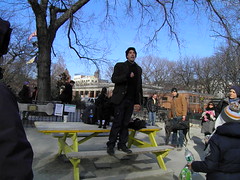 Carol Vinzant Drayton Michael, a dog trainer, discourages pet owners from carrying weapons to fend off dog attacks. He spoke to pet owners Sunday at the Tompkins Square Dog Run.
Carol Vinzant Drayton Michael, a dog trainer, discourages pet owners from carrying weapons to fend off dog attacks. He spoke to pet owners Sunday at the Tompkins Square Dog Run.Leave the knife, take a bottle of water.
That’s the advice Drayton Michael, a dog trainer known as the “pit bull guru,” is offering to the citizens of the East Village who are concerned about a series of attacks at the Tompkins Square Dog Run.
After a series of serious dog fights, to which some dog owners reportedly responded by carrying knives to the park to protect their dogs, the community was worried — though not all were sure these fights were anything new in a neighborhood that only a decade or so ago had more pit bulls than the toy breeds that now frolic in the specially segregated small dog run.
“Don’t worry,” said the dog run manager and dog trainer, Garrett Rosso, introducing Mr. Michael to the crowd of about 80 who gathered at an information session at the park on Sunday. “He knows that we’re not the type of dog run where people sit around on the edges and are afraid of certain breeds.”
Read more…
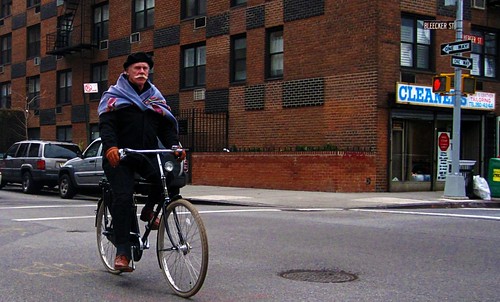 Michelle Rick
Michelle RickGood morning, East Village.
Even with the start of winter today, one of the summer’s most significant stories – the debate over the safety of bike lanes in the neighborhood – remains very much in the news.
The Post reports this morning on a 16 percent increase in collisions between bicycles and other vehicles during the past year, which notes that our neighborhood and downtown Brooklyn have the most perilous intersections. The piece attributes the spike to “rogue cyclists who have turned city streets into demolition derbies.”
“This was a catastrophe in the making as soon as they put those bike lanes up around the city,” The Post quotes a police officer in the neighborhood as saying. “They are arrogant. They think they now own the road and think they can do no wrong. Some even yell at police cars saying they have the right of way.”
In other neighborhood news, DNAinfo has a post about a Christmas tree vendor outside St. Marks Church in the Bowery who has been hit with a $1,500 fine for building a makeshift shack where his employees can stay warm.
 Emily Armstrong Some of the tapes from the archive of around 200 punk and new wave performances that will soon be preserved by The Fales Collection at New York University. The collection’s director calls it “the very best.”
Emily Armstrong Some of the tapes from the archive of around 200 punk and new wave performances that will soon be preserved by The Fales Collection at New York University. The collection’s director calls it “the very best.”The Fales Collection at New York University will shortly begin the process of preserving and cataloging an extraordinary video archive of punk and new wave performances known as “Gonightclubbing, Ltd.,” mainly recorded in the nineteen seventies at East Village clubs like CBGB using reel-to-reel video.
The archive is the work of video artists Emily Armstrong and Pat Ivers, and until collected by a team from Fales last week it occupied significant cupboard space in Ms. Armstrong’s apartment. Although the material has been presented at museum and theater shows, it has never been commercially available. Almost 200 live shows by acts like the Dead Boys, the Heartbreakers, Iggy Pop and Suicide have remained largely unseen since the two young cable TV employees hauled their gear around downtown clubs more than 30 years ago.
Fales has been collecting documentation of the downtown art scene since 1994. Marvin Taylor, director of the archive, told The Local, “You can’t talk about the art scene without talking about the birth of punk rock.” He described the Armstrong-Ivers material as the “premiere collection” of live recordings from the period, with great sound quality because the makers were able to record directly from the soundboards at clubs. “It’s the very best. I have never seen anything like it,” he said.
Read more…
 Gloria Chung
Gloria ChungGood morning, East Village.
We return today after a weekend build-up to holiday cheer. EV Grieve has a report on the tree-lighting in Tompkins Square Park and the “Unsilent Night” celebration. Like many of our readers, some of us will be making a list, checking it twice, then schlepping around the stores this week, so brace yourselves for a slightly less busy The Local than usual.
Nostalgia still abounds, though, as Bowery Boogie offers a look at some footage from a 1928 silent film shot in Washington Square Park and other parts of the neighborhood that shows how driving in New York was a perilous activity even back in the day.
And Ephemeral New York takes in some of the architectural details at 704 Broadway.
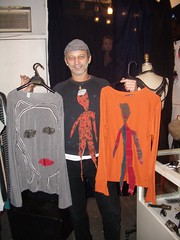 Allison Hertzberg Geová Rodrigues.
Allison Hertzberg Geová Rodrigues.Geová Rodrigues is a Brazilian fashion designer who opened his East Village shop, Geová Atelier, in 2001. After working as a painter in San Paolo, Geová came to New York City in 1992 and launched his first collection in 1998. Trading in his paint brush for fabric, needles, thread and tons of sequins, Geová’s designs have been featured in New York’s Fashion Week and in editorials worldwide.
Vivacious is the first word that comes to mind when trying to describe the designer. He’s effusive and talks to you like you’ve been friends for years. The same energy runs through his bright little shop located at 208 Avenue B. I recently sat down with Geová to better understand who he designs for, why he chose the East Village and how come grown men still play
with dolls.
Q.
Why did you choose the East Village as the place to open your shop?
A.
I love the East Village. I can get very inspired here. It’s a neighborhood with a great attitude. I love how the East Village embodies the same aesthetic as my clothing – a mixture of fabrics, textures and designs that come together to create something beautiful – just like the mix of languages, cultures and creative people that live in the East Village and make it the unique and interesting neighborhood that it is. Also, my first fashion show was in the East Village.
Read more…
Theresa Byrnes has been living in New York City since 2000, showing her art since age 16, and a rebel for as long as she can remember. “I have always valued being challenged more than being happy. Approval seems so stagnant and unexamined,” she wrote in her most recent blog post. And “I am not nice,” she said on her Twitter page, where she goes by the handle feistysparrow.
Ms. Byrnes is a portrait, abstract and performance artist in the East Village. Together, her three forms of expression make up what she calls her “holy trinity,” encompassing the body, mind and soul. The Australian-born Ms. Byrnes uses a wheelchair because of a degenerative nerve disease called Friedrich’s Ataxia. And yet Ms. Byrnes lives and creates with a distinct grace, fearless in her life as well as in her art.
“There is no forever,” she said recently in her East Ninth Street studio, wearing a paint-splattered smock and surrounded by works-in-progress. “It’s a bit boring to me, talking about identity and disability because my life is so beyond that. I’ve left all that way in the past.”
As for the way she sees life, Ms. Byrnes is firm. “There is nothing to fear, except your own illusion of identity,” she said. “Don’t protect yourself – reinvent. Break down the wall.”
NYU Journalism’s Robyn Baitcher reports.
 Michelle Rick
Michelle RickGood morning, East Village.
Always in the mood for radical political debate, East Village anarchists are divided on the Wikileaks affair, according to The Villager, some supporting Julian Assange’s exposure of government secrets while others wonder if Wikileaks isn’t a phony cover for a government assault on Internet freedom.
If the paranoia is too much, let I Love Charts take you back to a simpler time, when all you had to worry about it in the neighborhood were the Bowery Boys, with their contract killing, gambling and “stockpiling of weapons.” Famous for their dandy dress sense, we’re guessing the Bowery Boys would be shopping at EV Grieve if they were around today.
The corner bodega serves as the perfect pit stop for milk, eggs, bread, and, O.K., cigarettes. Beyond the staples, several East Village stores stock basics and treats in international flavors for gastro-curious locals as well as expats in search of a taste of home.
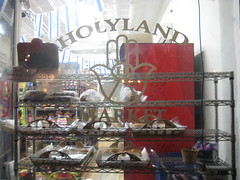 Carolyn Stanley Holyland Market, 122 St. Marks Place.
Carolyn Stanley Holyland Market, 122 St. Marks Place.Holyland Market
122 St. Marks Place
Holyland Market packs its modest space with dozens of Israeli goods. One popular item is Krembo, an air-light marshmallow fluff candy coated in chocolate. “Every kid in Israel grows up eating these,” says Omri Rosen, an employee of the store. The front shelves are filled with all manner of snacks, sweets and cookies, including Bamba — Cheetos-like peanut puffs—and specialty halvah in flavors like pistachio and coffee. Other Hebrew-labeled goods include jarred pickles and olives, couscous, and even cleaning products like sponges and mops. In addition to dry goods, Holyland carries fresh-baked burekas, savory pastries filled with mushroom, spinach or cheese.
A few unexpected items evoke a nostalgic response. “People get so excited when they see we carry OCB cigarette papers,” says Mr. Rosen. And Tim Tams, an Australian-brand cookie that’s very popular in Israel, has devotees from all over. Other than at the Tuck Shop, an Aussie cafe across St. Marks, the hollow, chocolate-coated treats are difficult to find, short of ordering them on eBay. “A couple of girls came in here yesterday and left with maybe seven boxes each,” Mr. Rosen says.
Read more…
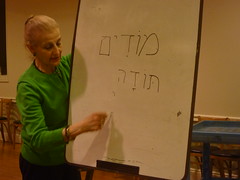 Hannah Rubenstein Carol Green, a religious instructor at the Town and Village Synagogue, teaches Hebrew to a group of adult bat mitzvah students. Although becoming a bar or bat mitzvah as an adult is hardly novel, the synagogue’s program is distinct because its participants undergo the ceremony as a group rather than independently.
Hannah Rubenstein Carol Green, a religious instructor at the Town and Village Synagogue, teaches Hebrew to a group of adult bat mitzvah students. Although becoming a bar or bat mitzvah as an adult is hardly novel, the synagogue’s program is distinct because its participants undergo the ceremony as a group rather than independently.In the basement of the synagogue on a windy Monday evening, a group of students hunch over prayer books, tracing ancient words from right to left with the tips of their fingers. At the end of the table, a woman stands at a whiteboard, writing large letters in careful, deliberate strokes. Because this is a beginning Hebrew class, the progress is halting. But the students are focused. No one glances around the room or shifts in her seat. Together, slowly, their voices chant:
“Baruch atah Adonai… elohaynu melech ha’olam… asher kidshanu… bemitzvotav vetzivanu… l’hadlik ner… shel Shabbat.”
After the last syllable fades away, the teacher breaks into a wide smile. At this rate, the students will surely be ready when the time comes to stand at the bimah and read the Torah in front of the whole congregation. Years of study have prepared them to become bat mitzvahs, to be recognized and welcomed into the Jewish faith as independent adults.
There is only one difference between these students and others around the world studying to become bar and bat mitzvahs — these are not boys and girls, nervously approaching their 13th and 12th birthdays, respectively. These are women between the ages of 20 and 80. This bat mitzvah class is for adults only.
Read more…
 Gloria Chung
Gloria ChungGood morning, East Village.
Those who fear a Starbucks on every corner might breathe a little easier this morning, as the company tells DNAinfo that it currently has no designs on First Avenue or Avenue A. Devotees of bric-a-brac will spare a thought for Billy LeRoy of Billy’s Antiques. Having failed to follow through with a threatened prosecution for illegally selling subway signs, according to Gothamist the city still won’t give him the signs back.
Meanwhile, the threatened Mars Bar has never, it seems, been so newsworthy. Marty Wombacher, who devoted the year to an attempt to visit 365 bars tells Jeremiah that his night at Mars Bar was the most fun of all. Also, evidence at Eater suggests that it’s Santa’s choice for refreshment before the rigors of Christmas night; although, wait – why are we seeing triple?
Some employees of the souvenir shops on St. Marks Place near Cooper Square say they are relying on Christmas sales to boost their revenue before the end of the year.
Business at Village Tattoo is so bad, says one employee, that the store might have to close its doors after 15 years.
Jason Smith, an employee at First Rich Gift Shop across the street tells The Local that revenue so far this December is less than half of what it was at the same time last year.
Vendors say the stores traditionally do well around the holidays and they hope that a break in the weather will bring shoppers into the streets – and maybe even motivate them to spend.
NYU Journalism’s Liz Wagner reports.
 Michelle Rick
Michelle RickGood morning, East Village.
At a moment when many people who live in our community are intensely focused on changes brought about by development and the loss of local institutions, The Times offers a fascinating look at new Census data showing how the demographics of neighborhoods in the New York region have shifted over the past decade.
The Lower East Side is cited in the piece as one of the locations in the region where the non-Hispanic white population has surged. The data comes from a five-year survey of neighborhoods across the country; the full Census report is expected to be released early next year.
The story also describes how segregation in city neighborhoods persists. “Most whites in the metropolitan area and most blacks in the city still live where a majority of their neighbors are of the same race,” the article notes. An interactive map also let’s you take a look at the data at the census tract level.
In other neighborhood news, EV Grieve, who last week was outraged by the apparent demise of a local willow tree near Eighth Street and Avenue C, re-visits the block this week and finds that the damage to the tree might not be as bad as originally feared.
The uniformed students of Girls Prep Lower East Side Elementary walk quietly in single file through neon orange hallways, under banners with slogans for the school’s four “core values”: sisterhood, scholarship, merit and responsibility. Since opening in 2005 as the first all-girls charter school in the city, it has been part of an ongoing experiment to boost performance in public schools. And for years now, students there have been quietly defying conventional wisdom about the link between income and academic performance.
At Girls Prep, where 98 percent of students are minority and almost three-quarters come from families with such low incomes that they qualify for free or reduced-price lunches, test scores have exceeded the state median the past few years – one of only a handful of schools in the East Village to do so.
NYU Journalism’s Andre Tartar reports.
 Gloria Chung
Gloria ChungGood morning, East Village.
We awoke this morning with a dusting of snow coating much of the neighborhood. It seems to have done little, however, to soothe the spirits of many in the neighborhood who fear the passing of some local iconic institutions.
Jeremiah’s Vanishing New York offers long take on the temporary closure of Mars Bar and some then-and-now photos that show how much the neighborhood has changed during the past seven years.
“When people talk about how the city is ‘always changing,’ I tell them this story,” the post reads. “The story of a historic, culturally relevant neighborhood sold down the river, demolished to the roots, and rebuilt into an unrecognizable playground for people passing through with money to burn. All in less than a single decade.” There’s more on Mars Bar at The Wall Street Journal and EV Grieve.
In other neighborhood news, Grieve also has a look at how a local artist traced the oddly-shaped buildings at the intersection of Bowery and Houston to property lines of 19th century farmers.
And The Athenaeum has a photo of Allen Ginsberg taken on the roof of his East Village apartment by William Burroughs in the fall of 1953.
 Phillip Kalantzis Cope
Phillip Kalantzis Cope‘Tis the season and we at The Local would like to hear your favorite memories about spending the holidays in the neighborhood.
In a place as distinct and atypical as the East Village, we’re sure that our readers have more than their share of holiday stories that are humorous or poignant, sad or bittersweet or even a little bawdy (within the bounds of good taste, of course) – and we’d like to hear them.
If you want to share your favorite holiday memory, e-mail us your stories in 400 words or less until Dec. 24 and we’ll publish some of the best ones.
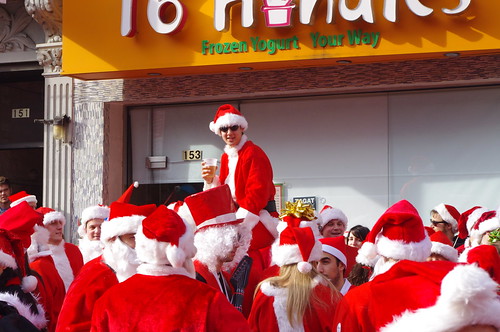 Bruce Monroe
Bruce MonroeGood morning, East Village.
We begin the week still trying to process many of the sights, sounds and, yes, smells of Santacon. During the weekend, hundreds of revelers dressed as St. Nick descended on East Village bars in an event that seemed to underscore neighborhood tensions around such issues as noise and alcohol. And, as if on cue, The Post offered two pieces over the past few days examining some of those very issues.
One article, headlined “Lower East Side Is Losing It” mourns the loss of Mars Bar, Max Fish and Pink Pony. “There are no neighborhoods in Manhattan anymore,” The Post quotes the author Richard Price saying. “South of Harlem, it feels like a bunch of districts where rich people can crash.”
The second piece took a wildly divergent view citing the recent Capital piece on Superdive to describe how “bohemian snobs” are driving “frat boys” out of the neighborhood. “The story of the East Village might be how little things have changed,” the author writes. “It’s still a cramped little hipster Vatican suspicious of outsiders.” Two pieces very much worth reading.
When the temperature turns arctic, outerwear is the best way to show off your personal style. On a recent frigid morning, The Local braved the elements to check out how East Villagers are bundling up this season. Classic double-breasted coats and perenially popular down jackets were seen on every corner, but quirky residents donned everything from a houndstooth tweed coat and a plush faux-fur vest to an animal print trench and a trendy army jacket.
NYU Journalism’s Sophie Hoeller and Sally Lauckner take a look at the neighborhood’s most distinctive winterwear.
 Meredith Hoffman Shaniqua Pippen said that she was denied admittance to the Continental bar by a bouncer who said “Your kind don’t know how to act.” Ms. Pippen joined a demonstration tonight at the bar.
Meredith Hoffman Shaniqua Pippen said that she was denied admittance to the Continental bar by a bouncer who said “Your kind don’t know how to act.” Ms. Pippen joined a demonstration tonight at the bar.Yelling “down with racism,” a group of 30 demonstrators gathered tonight outside the Continental Bar to protest what they said was a pattern of bias by the bar’s owners against African-American patrons.
“This is the first protest,” said Shaniqua Pippen, one of the demonstrators. “And I feel like if we continue more people will come, and something will change.”
Ms. Pippen, who is African-American, said that she was turned away from the bar in June when a bouncer, who is also African-American, told her “Your kind don’t know how to act.”
The owner of the Continental, Trigger Smith, denied that there was anything improper about the way that the bar screened its patrons.
“I’m not going to be politically correct and just let anybody in,” Mr. Smith said in an interview earlier this week. “I look at things in the long run — my bar’s been here 19 years — and I’ll turn away people if they don’t meet my dress code.”
Mr. Smith, who is white, said that patrons were not being turned away because of the color of their skin but because the bar has a policy against admitting patrons who do not adhere to its unwritten dress code.
“It just so happens that more people of a certain minority wear these things than others,” Mr. Smith said. “But I don’t want white trash either, or Jersey Shore boys.”
Read more…











